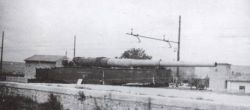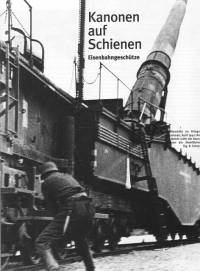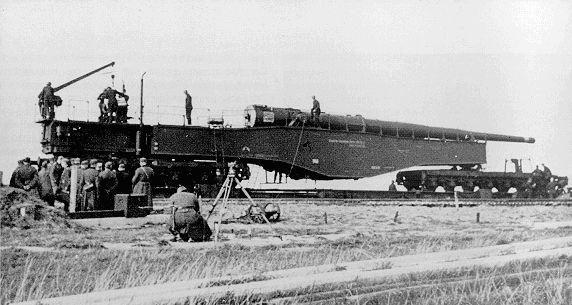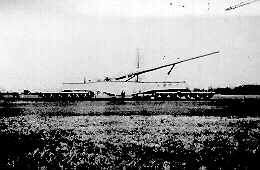 |
|
|
 |
 limited stock only ! |
|
| German Railway Artillery During World War II | |
Railway guns generally came in two types : those in which the gun was pivot-mounted, to fire in any direction relative to the line of track, and those in which the gun was rapidly aligned in its mounting and was capable only of a very small amount of traverse by moving the mounting bodily across the supporting bogies. The first type required stabilizing outriggers to resist the firing stress and to prevent the mounting tipping over when firing across the track. The second type - by and large those above 20cm / 8 in caliber - required either a curved track or a track turntable to allow them to point over a wide arc. Pushing the gun mounting along a curved track obviously changed the direction of fire and this was done for coarse pointing, the fine laying being done by the small on-mounting traverse. A turntable mounting was self-explanatory. Both these system demanded that special preparation, whether laying the curved track or assembling the turntable, was done before the gun could operate. Moreover it was usually necessary to construct track from the commercial railway system to the gun's chosen location. A point usually made in arguments against railway guns was the very fact that they relied on tracks, either commercial or specially - laid, and that such tracks were particularly vulnerable to air attack. This was quite true, but the track could also be easily and quickly repaired and one of the design features of a railway gun was that the suspension could negotiate indifferent and hastily-laid track without mishap. The Volege Drehscheibe (Vogele turntable)was developed by the German during the late 1920sas a necessary and vital accessory for the consequent employment of railway guns, and it was perfected in good time for extensive use during the war. The turntable gave all-round traverse to all railway guns and was a standard item of equipment. many German positions along the captured French and Belgian coasts were equipped with these turntables, ready to receive guns whenever needed for defense and thus speeding reaction time. German railway guns fell into two broad groups, those that were the result of long-term development and those that were hurriedly produced as a result so called Sofort-Programm ( Crash programme ) initiated in 1936 with the object of providing a sizable force of railway guns by the summer of 1939. One weapon fell into neither of these groups : the 80cm K(E) Gustav Gerät was developed outside both programs by Krupp, in its early stages more or less as a private venture. The long term programme was
principally concerned with the slow development of very long-range guns for bombardment.
In this the memory of the Paris -
Geschütz ( Paris Gun ) of 1918 played a part. The sofort-programm was begun
when it became obvious that the long-term development was not going fast enough to give
time to the development of smaller modern weapons, and so the products of the ' Crash
programme ' were elderly naval weapon that could be obtained from store and mounted on
modifications of World War 1 carriages. It is an odd fact that all German railway guns
were Krupp products; Rheinmetall-Borsig did design two
models, one of caliber 15cm and one of 24cm, but neither was accepted for service or even
built in prototype form. |
|
 This weapon, one of the best railway guns ever made, became the standard army
railway gun. Design of the K 5 began in 1934,
concurrently with the design of the 21cm K 12, the first gun entered
service in 1936 and from then until the end of war the K 5 was in regular
production, some 28 weapons having been made by 1945.
This weapon, one of the best railway guns ever made, became the standard army
railway gun. Design of the K 5 began in 1934,
concurrently with the design of the 21cm K 12, the first gun entered
service in 1936 and from then until the end of war the K 5 was in regular
production, some 28 weapons having been made by 1945.The design of the K5 and the K12 overlapped to some extent, as both were intended as a super long-range weapons employing deep-grooved barrels and splined projectiles. The K 5 barrel was made with 12 grooves 10mm (0.39"). A 15cm experimental barrel, known as the 15cm K 5M, was first made and tested, and as with the K 12 a normally-rifled barrel (the 15cm K 5 MKu) was built for comparative trials. |
|
 By 1936 a full-size barrel had
been made and proof-fired successfully at Krupp's Meppen test-range, and by 1937 a
complete equipment had been built and tested. Production then began and by 1940 eight were
in service. Then a sudden spate of split barrels occurred; an investigation produced no
definite conclusions but, more or less at hazard, the depth of the rifling grooves was
reduced to 7mm(0.28"). This appears to have been the correct solution since the
trouble never occurred again; the resulting guns well called K 5 Tiefzug 7mm. By 1936 a full-size barrel had
been made and proof-fired successfully at Krupp's Meppen test-range, and by 1937 a
complete equipment had been built and tested. Production then began and by 1940 eight were
in service. Then a sudden spate of split barrels occurred; an investigation produced no
definite conclusions but, more or less at hazard, the depth of the rifling grooves was
reduced to 7mm(0.28"). This appears to have been the correct solution since the
trouble never occurred again; the resulting guns well called K 5 Tiefzug 7mm. |
|
 The mounting was a straightforward
box-girder assembly carried on two twelve-wheel bogies. The gun was fitted into the usual
ring cradle and trunnioned directly to the mounting's side girders. It was originally
intended to brace the barrel, in similar fashion to the K 12, but trials
proved that bracing was un-necessary. The mounting was a straightforward
box-girder assembly carried on two twelve-wheel bogies. The gun was fitted into the usual
ring cradle and trunnioned directly to the mounting's side girders. It was originally
intended to brace the barrel, in similar fashion to the K 12, but trials
proved that bracing was un-necessary.The war time development of iron driving bands gave Krupp's designers hope that it might be possible to produce a normally-rifled K 5 barrel to work with FEW-banded shell. Towards the end of 1943, after successful completion of their experiments, a production multi-grooved barrel was issued. This was known as the K 5 Vz (Vielzug, many grooves) and about siw were manufactured. Consideration had meanwhile been given to extending the range. The first project was to develop a rocket-assisted shell that was eventually issued as the Raketen Granate 4331(R Gr 4331) and carried a cast-propellant rocket motor in the nose section. |
|
|
A picture tells
a thousand words... |
|
| continue.. Page 2 click NEXT. | |
|
|
||||||
|
©
one35th - Last updated on :
Sunday, April 27, 2008 |
|||||